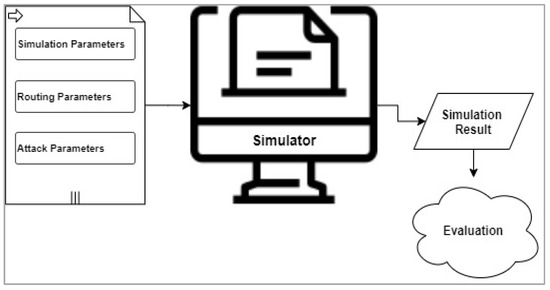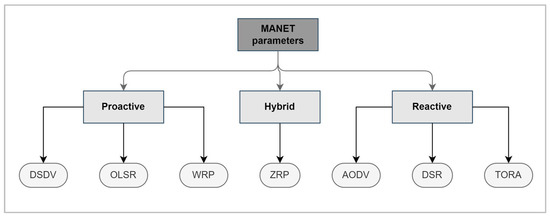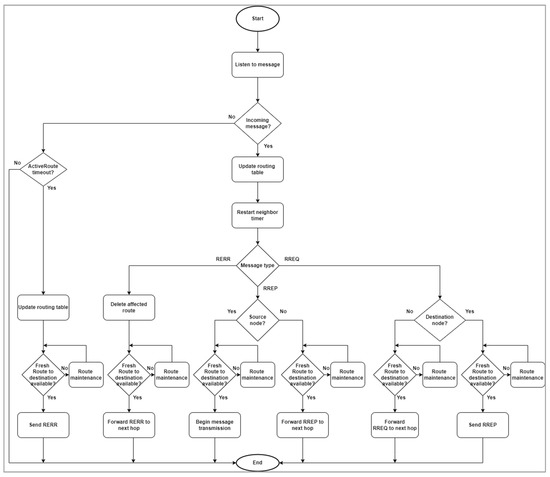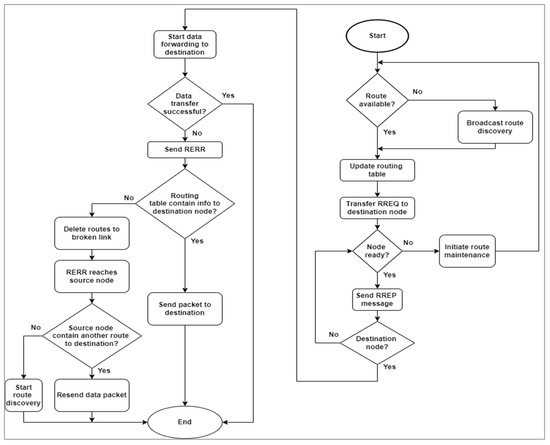A mobile ad hoc network (MANET) is an infrastructure-less network where mobile nodes can share information through wireless links without dedicated hardware that handles the network routing. MANETs’ nodes create on-the-fly connections with each other to share information, and they frequently join and leave MANET during run time. Therefore, flexibility in MANETs is needed to be able to handle variations in the number of existing network nodes. An effective routing protocol should be used to be able to route data packets within this dynamic network. Lacking centralized infrastructure in MANETs makes it harder to secure communication between network nodes, and this lack of infrastructure makes network nodes vulnerable to harmful attacks. Testbeds might be used to test MANETs under specific conditions, but researchers prefer to use simulators to obtain more flexibility and less cost during MANETs’ environment setup and testing. A MANET’s environment is dependent on the required scenario, and an appropriate choice of the used simulator that fulfills the researcher’s needs is important. Furthermore, researchers need to define the simulation parameters and the other parameters required by the routing protocol used. In addition, if the MANET’s environment handles some conditions where malicious nodes perform network attacks, the parameters affecting the MANET from the attack perspective need to be understood.
- MANET attacks
- MANET configuration parameters
- MANET evaluation
- MANET simulation
- aodv
- dsr
- olsr
1. Introduction

2. Routing in MANETs
-
Proactive routing protocols: For example, OLSR, each node maintains its routing table by periodically updating its information [6]; this increases network overhead. On the other hand, routes will always be available with a minimum delay. Proactive protocols provide better performance than reactive protocols as each node continuously updates its awareness of network changes. When a request is received, the packet forwarding procedure is directly handled.
-
Reactive routing protocols: For example, AODV and DSR, when a source node tries to perform a packet transmission, it initiates a route discovery mechanism to know how to reach the destination. After the route is determined and updated in the routing table, the packet is forwarded [7]. Reactive protocols have minimal network overhead, but there is a delay time consumed in the route discovery.
-
Hybrid routing protocols: For example, ZRP, the close local neighbors to a node are periodically updated, and the global nodes that are not direct neighbors will be updated on demand such as in reactive routing protocols [8].

2.1. AODV Routing Protocol
-
Destination node address;
-
Number of hop counts to reach the destination;
-
Intermediate nodes address;
-
Route entry expiry time;
-
Destination node sequence number.

-
Network diameter: The network diameter value sets the maximum number of hop counts between two nodes in MANETs. The network diameter default value is up to thirty-five hops at most as per RFC 3561 standard.
-
Node transversal time: The node transversal time is the estimation of packet transversal time between two neighbor nodes; this estimation should consider the network, processing, and transfer delay time. The default configuration time is 40 ms.
-
Network transversal time: The network transversal time is the expected time between sending the RREQ packet and the reception of the RREP packet as per the equation [14]:
-
Route request retry: If a route reply is not received by the source node within the maximum network transversal time, the source node can retry to request the route discovery again for a maximum route request retry times. If the route discovery exceeds the route request retry times, the destination node should be considered unreachable. The default value for the route request retry parameter is equal to 2 retries.
-
Blacklist timeout: When the RREP transmission from node A to node B fails, node A records node B in its blacklist buffer. During this blocking time, node A discards any RREQ from neighbor node B until the blacklist timeout is reached. After the blacklist timeout expires, node B is removed from the blacklist [14].
-
Route request rate limits: The route request rate limit is the maximum number of RREQ packets for the source node to originate per second. The route request rate limit’s default value is ten packets per second.
-
Active route timeout: The neighbor node is recorded in the routing table and considered an active node when the active route timeout is not exceeded. When a neighbor node is active, the recorded route to this neighbor should be used [15]. The active route timeout default value is 3000 ms.
-
Hello interval: All MANET nodes should reveal their existence in the network within a hello interval time [16]. If a node does not contribute to the routing activities for a hello interval time, it should broadcast a hello message with TTL = 1. Hello interval default value is set to be 1000 ms.
-
Allowed hello loss: If a node does not receive any contribution to routing activities from its direct neighbor node for more than (HelloInterval × AllowedHelloLoss), the node should assume a link failure to this neighbor [17]. The allowed hello loss default value is two link failures.
-
DPC: After the delete period constant time is expired, the expired route will be deleted from the routing table [18]. The default value for DPC is 5 s.
| AODV Parameter | Default Value |
|---|---|
| NetworkDiameter | 35 hops |
| NodeTransversalTime | 40 ms |
| NetworkTransversalTime | 1400 ms |
| RouteRequestRetry | 2 retries |
| BlackListTimeout | 2800 ms |
| RouteRequestRateLimits | 10 packets/s |
| ActiveRouteTimeout | 3000 ms |
| HelloInterval | 1000 ms |
| AllowedHelloLoss | 2 times |
| Delete Period Constant | 5 s |
2.2. DSR Routing Protocol
-
source node identifier;
-
destination node identifier;
-
route request identifier;
-
record listing the address of all intermediate nodes.

-
Discovery hop limit: The discovery hop limit value is defined as the limit to the route request re-broadcast. If the first attempt of RREQ does not reach the destination node, the default value of the discovery hop limit is 255 hops, and the minimum value is one hop.
-
Broadcast jitter: The destination node should delay the RREP message by a random value that does not exceed the broadcast jitter’s maximum delay time. The broadcast jitter default value is ten milliseconds.
-
Route cache timeout: The route cache timeout is associated with each route entry in the cache [23]. When the timeout is reached, this means that the related route is not used and needs to be deleted from the node’s cache. Route cache timeout default value is three hundred milliseconds.
-
Send buffer timeout: When a packet cannot be transmitted to the next-hop node, this packet is queued inside a buffer to try sending it when possible. Send buffer timeout is the maximum time associated with a packet to be sent before being removed from the send buffer. The default value for send buffer timeout is 30 s.
-
Max request period: After a route discovery attempt fails to find a route to the destination node, the time between successive route discovery attempts doubles until the maximum request period is reached. The default value for the maximum request period time is 10 s.
-
Re-transmit buffer size: Re-transmit buffer holds the maximum number of packets waiting for the next-hop reachability confirmation. If the buffer is not sufficient to keep the new packet, this packet is discarded without notification. The re-transmit buffer size defines the buffer size with a default value of 50 packets.
-
Max maintenance re-transmission: The maximum number of re-transmissions for a packet waiting for a confirmation from the next hop should be limited by the configuration value of the max maintenance re-transmission parameter. The default value is only two transmissions.
3.0. Simulation in MANETs
MANET technology is rapidly changing, and new protocols and mechanisms are continuously proposed by researchers. Evaluating a network’s performance under different attacks is important to be able to propose protection mechanisms. Therefore, a cost-effective method that empowers researchers to set up and test MANETs plays a key role in research.
3.1. MANETs Simulators
Simulators are software tools used to create a virtual environment that supports researchers to set up and test a network’s performance under different conditions. Simulators are GUI-driven tools used to set up a network environment and then perform different attacks on the defined network or make comparisons between a standard routing protocol and a newly proposed protocol. Using the defined evaluation metrics, a simulator is also capable of collecting the network’s results and evaluating the overall performance [30].
There is another method for developers to define and test MANETs using testbeds. Testbeds are experimentation in-lab networks that researchers can set up using dedicated hardware sets for this purpose. Testbeds lack the flexibility to define a MANET network, as MANETs are dynamic networks where nodes continuously join and leave the network. Additionally, the cost is much higher than software simulations to define a MANET using testbeds.
To be able to select a suitable simulator, the researchers need to know the simulator’s key features [31]. Table 2 is a comparison between the widely used simulators in MANETs.
Table 2. Comparison between simulation tools in MANETs.
|
Simulator Name |
Languages Supported |
Platform Support |
License |
Advantages |
Disadvantages |
|
OPNET |
C, C++ |
Windows, Sun Solaris, RedHat Linux |
Commercial, Free Educational License |
-User-friendly and easy to use. -Provides additional supportive tools. |
-Limited wireless mobility. -Not open source and supported protocols are limited. -Expensive. -Lack of energy model. |
|
OMNeT++ |
C++, NED |
Windows, MacOS, and any Unix-like systems |
Open source |
-Used by a wide number of users. -Extensive GUI interface. -Intelligence support. -Rich C++ libraries. -Parallelly distributed simulation is supported. |
-Documentation is poor. -Performance measures are weak. -Does not cover all protocols. |
|
NS-2 |
C++, OTCL |
Windows, MacOS, Ubuntu, Sun Solaris, Fedora Linux, and any Unix-like systems |
Open source |
-The most used simulator for research. -Good with complex systems’ evaluation. -Provides energy model. -Supports wired and wireless networks. |
-Documentation is poor. -Simulation is not real-time. -Lack of supporting tools. -Not suitable for large systems. -Difficult to use and poor GUI. -High computational overhead and memory usage. |
|
NS-3 |
C++, Python |
MacOS, FreeBSD, Linux |
Open source |
-Very fast simulator where parallel simulation is supported with real-time scheduling. -Supports emulation. -Provides debugging traces. -Organized source code with low-level abstraction. -Good documentation. |
-Lacks backward compatibility with NS-2. -Virtualization support is limited. -Difficult to use. |
|
GloMoSim |
C, PERSEC |
Windows XP/7, FreeBSD, Sun Solaris, Fedora Linux |
Free |
-Scalable and can handle very large systems with thousands of nodes. -Parallel simulation environment. -Scalable simulation library. |
-Documentation is poor. -The simulator is outdated. -Does not support end devices such as simulators.
|
|
QualNet and EXATA/cyber |
JAVA |
Windows NT/2000/XP/Professional, macOS, Sun Solaris, and most Unix-like systems |
Commercial |
-Provides animation tools. -Scalable and can handle very large systems with thousands of nodes. -Support wired and wireless networks. - Realtime simulator
|
-Slow interfaces. -Difficult to install. -Expensive. |
|
JIST/SWANS |
JAVA, Tcl |
Windows, macOS, Sun Solaris Linux |
Commercial |
-Powerful simulator and suitable for simulating real-world systems. -Less memory usage. |
-Features not competing with other simulators. |
|
J-SIM |
JAVA |
Windows, Sun Solaris Linux |
Open source |
-Supports wired and wireless networks. -Reusable models with good flexibility. |
-Worst execution time. |
4. Evaluation Metrics and Performance Analysis in MANETs
-
THPT: Throughput is the rate of successfully delivered packets that reached the receiver node per time slot [43]. Throughput is affected by topology changes, noise on communication links, the power of transmission from the source node, and the existence of malicious nodes affecting the throughput ratio.
-
AETED: Average end-to-end delay is the average time taken to send a packet to the destination node [44]. This delay is due to many reasons such as route discovery queuing and process latency, delays caused by wireless links, and processing delays at both the sender and the receiver sides.
-
PDR: Packet delivery ratio is the ratio of packets that are received by the destination across the overall transmitted packets from the source node [45]. The packet delivery ratio represents the maximum throughput that can be achieved by the MANET network.
-
PLR: The packet loss ratio is the opposite of PDR; PLR measures the total lost packets that did not reach the destination node across the overall transmitted packets [46].
-
ROR: Routing overhead ratio is the size of control and header packets needed by the protocol for route discovery and maintenance over the total data packets received by the destination node [47].
-
NRL: Normalized routing load is the ratio between the total number of control packets sent by a source node over the total number of data packets received by a destination node [48]. An increase in normalized routing load metric indicates the efficiency of the used routing protocol.
-
NL: The network load is the average amount of data packets that are being carried by the entire network over time [49]. Increasing the network load ratio increases the possibility of data collision in the wireless medium.

This entry is adapted from the peer-reviewed paper 10.3390/electronics12091956
